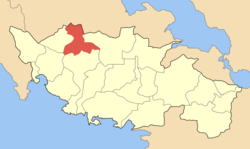Chaeronea
| Chaeronea Χαιρώνεια | |
|---|---|
 Chaeronea | |
|
Location within the regional unit  | |
| Coordinates: 38°31′N 22°51′E / 38.517°N 22.850°ECoordinates: 38°31′N 22°51′E / 38.517°N 22.850°E | |
| Country | Greece |
| Administrative region | Central Greece |
| Regional unit | Boeotia |
| Municipality | Livadeia |
| Population (2001)[1] | |
| • Municipal unit | 2,218 |
| Community | |
| Time zone | EET (UTC+2) |
| • Summer (DST) | EEST (UTC+3) |
| Vehicle registration | ΒΙ |
Chaeronea (/ˌkaɪrəˈniːə/ or /ˌkɛrəˈniːə/;[2] Greek: Χαιρώνεια, Chaironeia, Ancient Greek: [kʰai̯rɔ̌ːneːa]) is a village and a former municipality in Boeotia, Greece, located about 80 kilometers east of Delphi. Since the 2011 local government reform it is part of the municipality Livadeia, of which it is a municipal unit.[3] Population 2,218 (2001). It is located by the mountain Thourion and in the Kifisós river valley, NW of Thebes.
History

First settled in the Prehistoric period at the site now known as Magoula Balomenou (Μαγούλα Μπαλωμένου), its older name was Arne. Chaeronea was subject to Orchomenus which was, beginning in 600 BCE, a member of the Boeotian League. In the late 5th century BCE, Chaironeia belonged to one of the 11 Boeotian districts along with Acraephnium and Copia.
Chaeronea was the site of several historical battles. Best known is that of 338 BCE, between Philip II of Macedon and a coalition of various Greek states, mainly Thebes and Athens. During the battle, the elite unit of Theban soldiers known as the Sacred Band of Thebes was wiped out completely (See Battle of Chaeronea). In 1818, the so-called Lion of Chaeronea, a nearly 20-foot-tall (6.1 m) funerary monument erected in honor of the Sacred Band, was rediscovered by English travellers. The fragmentary monument was reassembled and installed in 1902 by an organisation called the Order of Chaeronea atop a pedestal at the site of its discovery.[4] The ancient biographer and essayist Plutarch was born in Chaeronea, and several times refers to these and other facts about his native place in his writings.
Other battles around Chaeronea:
- Between Chaeroneans and Atheneas in 447 BCE when Athenians succeeded in putting Chaeronea under their control.
- In 146 BCE the Roman general Matellus defeated a unit of 1,000 Arkadians.
- In 86 BCE, Archelaus and Taxilos, generals of Mithridates VI of Pontus, landed in Boeotia. They were met by the Roman general Lucius Cornelius Sulla near Chaeronea and in the ensuing battle the Mithridatics were defeated and retreated to Chalkis.[5]
- Battle between Catalans and Franks in March 15, 1311. The Catalan Company defeated the Franks and took control of great part of Greece. Turks participated with the side of Catalans. The battle is described by Ramon Muntaner, a Catalan soldier.
- Battle between Greeks and Turks in 1823 and 1825 during the Greek Revolution (1821-1828).

The site of the Theban mass grave was excavated in 1879-80 by P. Stamatakis, and the prehistoric site of Magoula Balamenou 23 years later by the archaeologist G. Soteriadis.
References
- ↑ De Facto Population of Greece Population and Housing Census of March 18th, 2001 (PDF 39 MB). National Statistical Service of Greece. 2003.
- ↑ Frank H. Vizetelly, A Desk-Book of Twenty-five Thousand Words Frequently Mispronounced (New York and London: Funk & Wagnalls, 1917), p. 252.
- ↑ Kallikratis law Greece Ministry of Interior (Greek)
- ↑ 'An Army of Lovers' - The Sacred Band of Thebes
- ↑ Dictionary of battles from the earliest date to the present time (1904), pp. 54, 55.
| ||||||||||||||||||||||